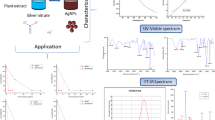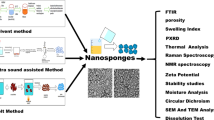Abstract
Ciprofloxacin, a poorly soluble drug-loaded chitosan nanoparticle, was prepared for the treatment of microbial infections. Nanoformulation of ciprofloxacin was prepared using 85% deacetylated chitosan as a biodegradable polymer and tripolyphosphate (TPP) as a cross-linking agent by ionotropic gelation. It was further evaluated and characterized on the basis of morphology, drug loading efficiency, X-ray diffraction, zeta potential value, Fourier transform infrared study, antimicrobial study, and also in vitro release behavior of ciprofloxacin. The FTIR spectral studies indicated that there was no interaction found between the drug and chitosan. The sample CS1 formulation was found stable with good drug entrapment efficiency, fair zeta potential value, and its size ranged between 100 and 200 nm. The in vitro study showed sustained release behavior with steady rise in cumulative drug release (> 99%) for up to about 8 h and thereafter, no significant release observed. The characterized formulations were also used to study antimicrobial activity.








Similar content being viewed by others
References
Wu, G., Wang, G., Fu, X., & Zhu, L. (2003). Synthesis, crystal structure, stacking effect and antimicrobial studies of novel quaternary copper (II) complex with quinolone. Molecules, 8, 287–296.
LG, S., & WN, K. (1997). Development of ciprofloxacin: the USA perspective. In W. APR & R. N. Gruneberg (Eds.), Ciprofloxacin: 10 years of clinical experiences (pp. 1–5). Oxford: Published by Maxim Medical.
British Pharmacopia (BP). (2009). (493). London: The stationary office; 493.
Blondeau, J. M. (2004). Fluoroquinolones: Mechanism of action, classification, and development of resistance. Survey of Ophthalmology, 49(2), S73–S78.
Wilhelmus, K. R., Hyndiuk, R. A., Caldwell, D. R., Abshire, R. L., Folkens, A. T., & Godio, L. B. (1993). 0.3% ciprofloxacin ophthalmic ointment in the treatment of bacterial keratitis. The ciprofloxacin ointment/bacterial keratitis study group. Archives of Ophthalmology, 11, 1210–1218.
Acar, J. F., & Goldstein, F. W. (1997). Trends in bacterial resistance to fluoroquinolones. Clinical Infectious Diseases, 24(1), S67–S73.
Huneault, L. M., Lussier, B., Dubreuil, P., Chouinard, L., & Désévaux, C. (2004). Prevention and treatment of experimental osteomyelitis in dogs with ciprofloxacin-loaded crosslinked high amylose starch implants. Journal of Orthopaedic Research, 22(6), 1351–1357.
Mehnert, W., & Mader, K. (2001). Solid lipid nanoparticles: production, characterization and applications. Advanced Drug Delivery Reviews, 47(2–3), 165–196.
McCarron, P. A., & Hall, M. (2008). International Journal of Pharmaceutics, 348, 115–124.
Goya, S., Rai, J. K., Narang, R. K., & Rajesh, K. S. (2010). International Journal of Pharmacy and Pharmaceutical Sciences, 2(2), 1–6.
Gunatillake, P. A., & Adhikari, R. (2003). European Cells and Materials, 5, 1–16.
Lam, X. M., Duenas, E. T., Daugherty, A. L., Levin, N., & Cleland, J. L. (2000). Journal of Controlled Release, 67, 281–292.
Cohen, S., Yoshioka, T., Lucarelli, M., Hwang, L. H., & Langer, R. (1991). Pharmaceutical Research, 8, 713–720.
Thanou, M., Verhoef, J. C., & Junginger, H. E. (2001). Chitosan and its derivatives as intestinal absorption enhancers. Advanced Drug Delivery Reviews 50 Suppl, 1, S 91–S101.
Suri, S. S., Fenniri, H., & Singh, B. (2007). Nanotechnology-based drug delivery systems. Journal of Occupational Medicine and Toxicology, 2, 1–6. https://doi.org/10.1186/1745- 6673-2-1.
Calvo, P., Remuan-Lopez, C., Vila-Jato, J., & Alonso, M. (1997). Journal of Applied Polymer Science, 125132, 63.
Acknowledgements
The authors would like to acknowledge the financial support from the Department of Science & Technology-INSPIRE fellowship, New Delhi, India. Prof. R.K.Mandal (Department of Metallurgical Engineering, IIT, BHU, Varanasi) for providing SEM facility, CISF, IIT,BHU for providing XRD facility & S.K. Singh (Department of pharmaceutics, IIT, BHU, VARANASI) for providing zeta potential and FTIR facility.
Author information
Authors and Affiliations
Corresponding author
Ethics declarations
Conflict of Interest
The authors declare that they have no conflicts of interest.
Rights and permissions
About this article
Cite this article
Singh, K., Mishra, A. & Singh, A. Synthesis Characterization and In Vitro Release Study of Ciprofloxacin-Loaded Chitosan Nanoparticle. BioNanoSci. 8, 229–236 (2018). https://doi.org/10.1007/s12668-017-0470-7
Published:
Issue Date:
DOI: https://doi.org/10.1007/s12668-017-0470-7




